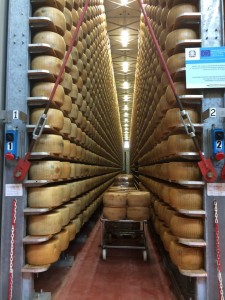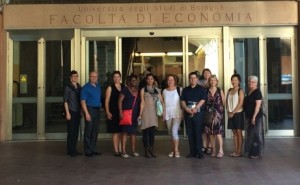 CDS specialist advisor Jaye Martin recently took part in a study trip to Emilia Romagna, the area of northern Italy with probably the richest co-operative history in the world.
CDS specialist advisor Jaye Martin recently took part in a study trip to Emilia Romagna, the area of northern Italy with probably the richest co-operative history in the world.
Here, she reflects on the visit and looks at how Scotland can learn from the region.
The tour I was lucky enough to be part of was a collaboration between the University of Bologna and Saint Mary’s University (SMU) in Halifax, Canada. I joined a group of students undertaking a part-time Master’s Degree in Co-operative Management at SMU, all of whom are managers at co-operatives across Canada and the United States. Their organisations include food co-ops, insurance co-ops, credit unions and co-op development and their experiences provided me with valuable insight.
Our chief executive, Sarah Deas, wrote a series of comprehensive blogs on her own experiences in Emilia Romagna a couple of years ago. With that in mind, I thought I’d simply touch on my highlights reel – although I can assure you that it was an intense eight days packed with visits to co-operatives and lectures on co-operative theory and economics!
So here’s my five most interesting points of learning:
1. Co-operatives are one of the most important tools in the reduction of inequality Bologna – the capital of the Emilia Romagna region – has a lower unemployment rate than other Italian cities. Emilia Romagna itself ranks first in Italy in terms of equality, evidenced by high average income and low income inequality. Female participation in the workplace is significantly higher in Emilia Romagna (c65%) than in the rest of Italy (c45%). All of this can be linked back to the presence of co-operatives in the area.
 2. Social co-operatives… the future?
2. Social co-operatives… the future?
Legislation was introduced in Italy to create the legal and tax structure for the ‘social co-operative’ (what we might call a ‘social firm’). At least 30% of employees must be categorised as disadvantaged (e.g. those affected by drug or alcohol addiction, physical or mental disabilities). We visited some wonderful examples, such as Cooperativo Il Cammino e L’altro Giardino (‘The Alternative Garden’), a residence and gardens where herbs, fruit and vegetables are grown and used to make products such as jams and syrups. Social co-operatives were oft-mentioned as the potential future growth area of the sector, but funding and support is increasingly hard to come by – so much will depend on the economic sustainability of projects and how they diversify and adapt to achieve this.
3. Caseificio 4 Madonne and the mix of the traditional and the innovative
My favourite visit – and not just because we got to taste all the lovely Parmigiano Reggiano cheese! Caseificio 4 Madonne is one of 350 Parmigiano Reggiano co-operatives in the region and together they form a huge consortium. Caseificio 4 has 65-70 member farmers and produces 104 wheels of cheese each day. We were shown the various stages of production and I was struck by the clever merging of traditional methods (e.g. use of muslin cloths and copper cauldrons) and innovative methods without the loss of the integrity and provenance of the product. Perhaps something for Scottish food and drink companies to consider?
4. Co-operative funds – replicable here?
Co-operatives in Italy must pay 3% of their annual profits into one of three funds (each controlled by one of the three co-operative associations). We visited Coopfond, the largest of the funds at 422m EUR and controlled by Legacoop. The fund is used for the promotion of start-up co-operatives, growth capital for expansion and support for co-operatives in financial distress. They will also help fund worker buyouts such as Greslab. Given the issues around access to finance for employee-owned businesses and co-operatives in the UK, could a similar initiative be a potential game-changer?
5. The importance of international connections
This study trip was important not just for the opportunity to see and hear about the strength of co-operative models in the region, but also to meet and discuss with fellow co-operators from Italy, Canada, USA and England. Everyone in the group had a different interest or angle to their observations and questions and, for me, that was just as fascinating as the visits and lectures themselves. What is clear is that we should seek to build on these experiences, relationships and learning as far as possible as we continue to support company growth in Scotland using co-operative business models.


